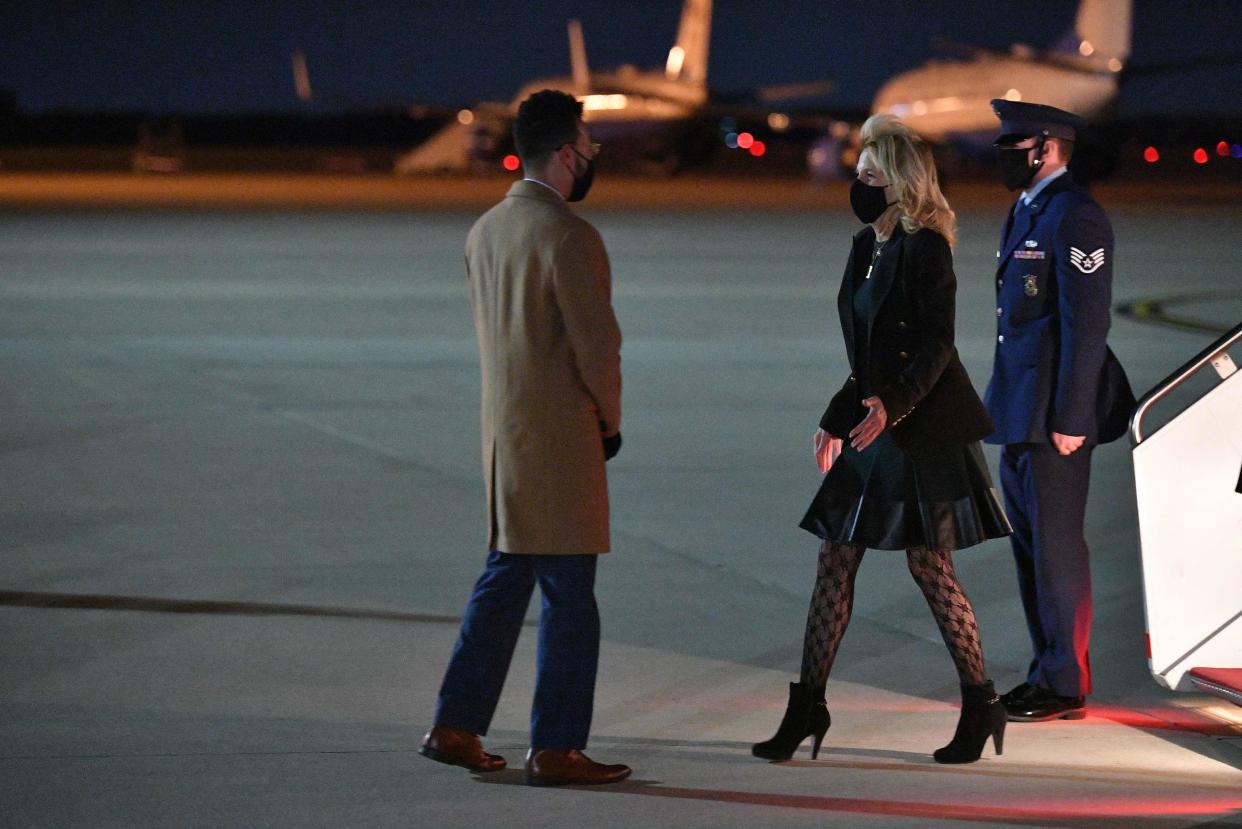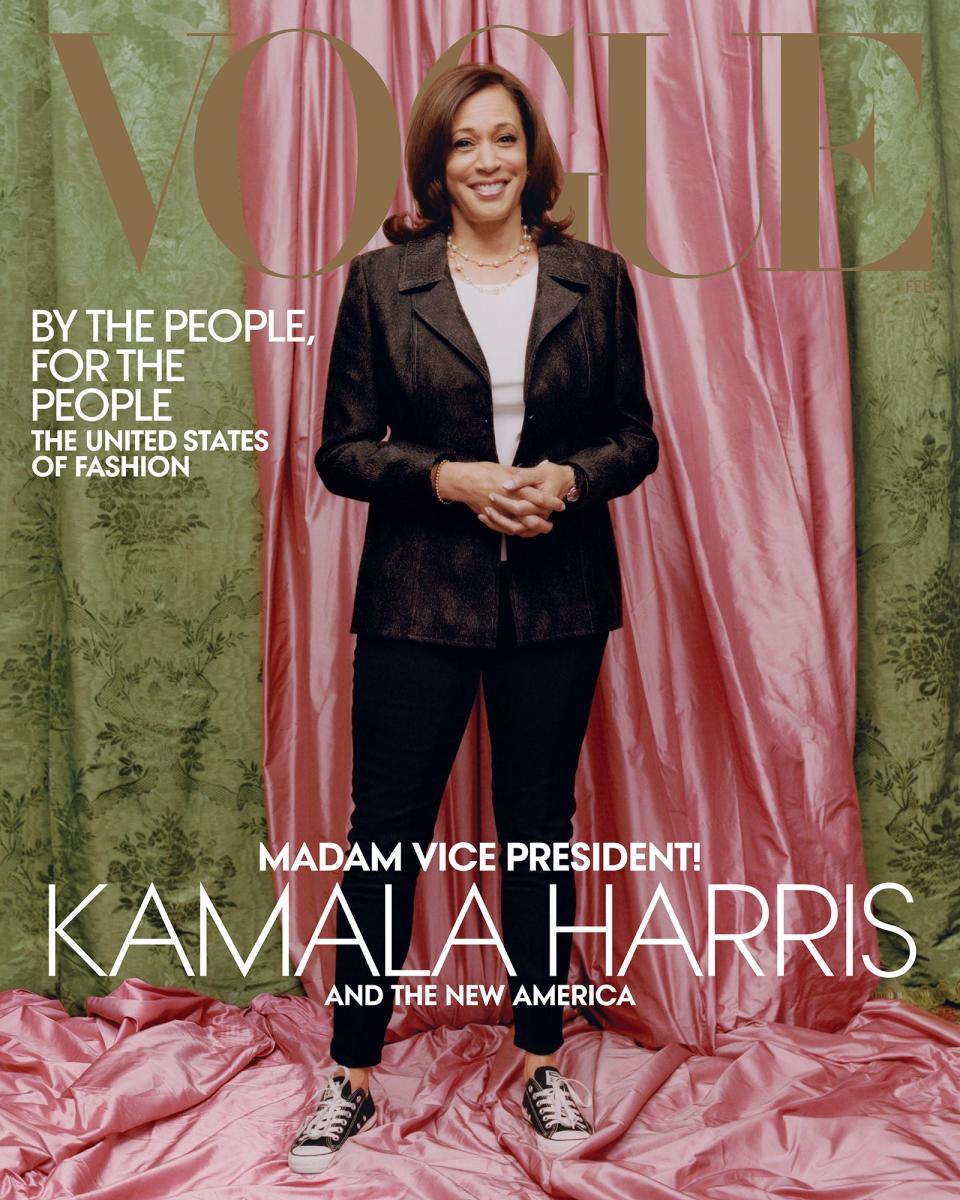Jill Biden’s tights and why society is obsessed with what older women wear

- Oops!Something went wrong.Please try again later.
When photos were snapped in April of first lady Jill Biden wearing patterned tights, she became the focus of online chatter. Many misidentified the hosiery as fishnet stockings, and some were quick to label Biden as "too old to be dressing like that," while others defended her.
Similarly, when Diane Keaton sported thigh-high boots in April, it made international headlines.
Why do we care what older women wear? Experts say it's because our society is inherently sexist and ageist, and as a result, women like Keaton, 75, and Biden, 70, are put under a microscope as they make fashion choices, particularly if those choices are not in line with what is deemed "appropriate" for their age.
"Sad to say, even in the year 2021, no matter how accomplished a woman is, no matter the height of her power and leadership, she is still in this society of sexism and gendered ageism; she still is judged by her looks," says Leora Tanenbaum, author of "I Am Not a Slut: Slut-Shaming in the Age of the Internet." "And we need to fight back against that, but that's the culture we're in."
In a Vogue cover interview in June, Biden said it's "kind of surprising, I think, how much commentary is made about what I wear or if I put my hair in a scrunchie. I put my hair up! Or the stocking thing," adding the tights weren't fishnets or lace, but "very pretty stockings."
"It’s amazing how much people pay attention to every little detail."
Juliet A. Williams, a professor at the University of California, Los Angeles' Department of Gender Studies, says the image of a carefree, confident woman who is playful with her look is "threatening in our society" because it signals "breaking free of the constraints of beauty."
These constraints can influence how women dress, how they speak and what they say, which leads to the "persistent subordination of women," according to Williams.
Tanenbaum says our fixation on what women wear starts young, and women are expected to present themselves in a way that conforms to a fairly narrow idea of what is physically attractive.
"When you're younger, the pressure is to look sexy, to look hot... As you get older, and you kind of age out of those pressures and expectations, you're still supposed to conform to a very narrow set of rules and guidelines that are never really spelled about what you're supposed to look like physically," she says.
'Damned if we do, damned if we don't'
Older women are expected to appear "well-preserved," Tanenbaum says, but they will be criticized if they go too far in the other direction as well.
"You still do need to care and show that you've put some effort into your appearance but here's the rub – although you are supposed to put effort into your appearance, you're never, ever supposed to show the effort that goes into it," she explains.

Tanenbaum describes this as a no-win situation, pointing to Keanu Reeves' girlfriend Alexandra Grant, 48, who turned heads when she walked the red carpet sporting gray hair. While some praised her for "looking her age," others mocked her for looking old.
"We really are damned if we do, damned if we don't," Tanenbaum says. "Whichever side you go to – trying too hard... or acting like you're not trying at all – You're still going to be mocked, you're still going to be maligned."
The problem with being 'appropriate'
Williams says the concept of "looking one's age" is problematic and is at the heart of society's fixation on older women and their fashion choices.
"Appropriateness has always had written into it a gender-based double standard," Williams says. "What's appropriate for women is different than what's appropriate for men."

Williams says our attitudes about sex and gender must shift so society is not holding women to "antiquated ideals of modesty."
Appropriateness and professionalism of dress are also played heavily when women run for office. From Kamala Harris' converse to Hillary Clinton's pantsuits, everyone had an opinion.
In a 2016 interview, Donald Trump said he didn't think Clinton, then-68, "had a presidential look."
"So what is the presidential look, to be a white man?" Tanenbaum questions.
Marya T. Mtshali, a lecturer in Studies of Women, Gender and Sexuality at Harvard University, says this is part of the policing of women's bodies.
"We don't focus on fashion choices of male politicians nor should we be focusing on the fashion choices of female politicians," she says. "It still happens, but we shouldn't be focusing on that, we should be listening to the content of what they have to say and the policies that they're putting forth."
The standards are even more extreme for women of color
“Imagine if Jill Biden was a Black or Latina woman. This patterned tight, it would have been viewed much differently because... we have these stereotypes in our society that they are more promiscuous and more sexually available," explains Mtshali.
Michelle Obama, for example, was ridiculed for wearing a sleeveless dress for her first official portrait after becoming the first lady despite others in her position, like Jacqueline Kennedy, sporting the same look with no fuss.

It also goes beyond dress. For example, few women of color in political offices show off their natural hair, Mtshali notes.
"I think that's because they don't feel like they will be elected if they do (because) our society is very Eurocentric," she says.
'We have to change in our culture'
In order to solve these issues, "we have to change in our culture – how we view women, how we treat women," Mtshali says.
Tanenbaum suggests we effectively "banish the word appropriate" in the context of women's fashion choices and their age.
“We already are dealing with such a narrow range of options, no matter what our age, and then it's getting narrowed even more... if you're over 40, 50, 60," she says.
Mtshali says a good first step for change is being aware of unconsciously internalized sexist or ageist ideas.
"We are all socialized in the same society, so (women also experience) internalized sexism and internalized misogyny," she says. "We have to do this internal work... to try to figure out the ways in which (we) hold these biases."
We also need to call out biases when we see them, she says, whether it's pointing out unfair policies within school dress codes or holding politicians accountable who perpetrate problematic rhetoric around the fashion of their female colleagues.
Another step is for women to be more unapologetic when possible.
"I think the best course of action is for us to not apologize for our choices. Jill Biden and Diane Keaton should rock their looks, and they should just own it," Tanenbaum says. "This is who I am. This is what I decided to put on this morning. This is what I look like. Deal with it."
This article originally appeared on USA TODAY: Jill Biden's tights: Why society cares about what older women wear

